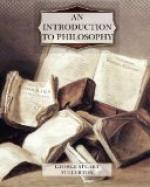It is, in fact, not concerned with truths, but with assumptions, and with assumptions which are supposed to be made on the basis of no evidence. It is concerned with “seemings.”
The distinction is a very important one. Our Turk cannot, by willing to believe it, make his hypothesis true; but he can make it seem true. Why should he wish to make it seem true whether it is true or not? Why should he strive to attain to a feeling of subjective certainty, not by logically resolving his doubts, but by ignoring them?
The answer is given us by our author. He who lives in the midst of doubts, and refuses to cut his knot with the sword of belief, misses the good of life. This is a practical problem, and one of no small moment. In the last section of this book I have tried to indicate what it is wise for a man to do when he is confronted by doubts which he cannot resolve.
Into the general question whether even a false belief may not, under some circumstances, be more serviceable than no belief at all, I shall not enter. The point I wish to emphasize is that there is all the difference in the world between producing a belief and proving a truth.
We are compelled to accept it as a fact that men, under the influence of feeling, can believe in the absence of evidence, or, for that matter, can believe in spite of evidence. But a truth cannot be established in the absence of evidence or in the face of adverse evidence. And there is a very wide field in which it is made very clear to us that beliefs adopted in the absence of evidence are in danger of being false beliefs.
The pragmatist would join with the rest of us in condemning the Turk or the Christian who would simply will to believe in the rise or the fall of stocks, and would refuse to consult the state of the market. Some hypotheses are, in the ordinary course of events, put to the test of verification. We are then made painfully aware that beliefs and truths are quite distinct things, and may not be in harmony.
Now, the pragmatist does not apply his principle to this field. He confines it to what may not inaptly be called the field of the unverifiable. The Turk, who wills to believe in the hypothesis that appeals to him as a pious Turk, is in no such danger of a rude awakening as is the man who wills to believe that stocks will go up or down. But mark what this means: it means that he is not in danger of finding out what the truth really is. It does not mean that he is in possession of the truth.
So I say, the doctrine which we are discussing is not a method of attaining to truth. What it really attempts to do is to point out to us how it is prudent for us to act when we cannot discover what the truth is.[6]
[1] “An Essay concerning Human Understanding,” Book II, Chapter I, section 2.
[2] Book I, Chapter I, section 4.
[3] Book I, Chapter I, section 1.




